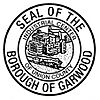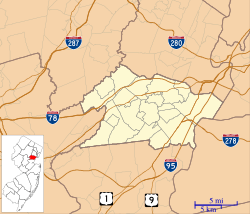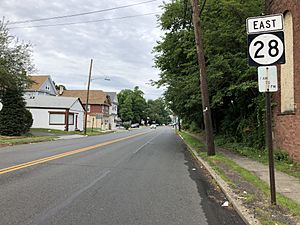Garwood, New Jersey facts for kids
Quick facts for kids
Garwood, New Jersey
|
|||
|---|---|---|---|
|
Borough
|
|||
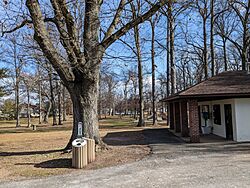
Unami Park in Garwood
|
|||
|
|||
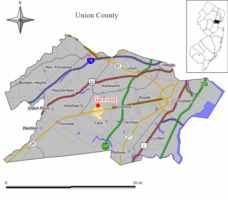
Location of Garwood in Union County highlighted in yellow (left). Inset map: Location of Union County in New Jersey highlighted in black (right).
|
|||
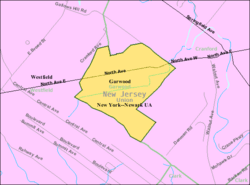
Census Bureau map of Garwood, New Jersey
|
|||
| Country | |||
| State | |||
| County | Union | ||
| Incorporated | March 19, 1903 | ||
| Government | |||
| • Type | Borough | ||
| • Body | Borough Council | ||
| Area | |||
| • Total | 0.65 sq mi (1.68 km2) | ||
| • Land | 0.65 sq mi (1.68 km2) | ||
| • Water | 0.00 sq mi (0.00 km2) 0.00% | ||
| Area rank | 532nd of 565 in state 20th of 21 in county |
||
| Elevation | 82 ft (25 m) | ||
| Population
(2020)
|
|||
| • Total | 4,454 | ||
| • Estimate
(2023)
|
5,161 | ||
| • Rank | 397th of 565 in state 20th of 21 in county |
||
| • Density | 6,848.2/sq mi (2,644.1/km2) | ||
| • Density rank | 69th of 565 in state 8th of 21 in county |
||
| Time zone | UTC−05:00 (Eastern (EST)) | ||
| • Summer (DST) | UTC−04:00 (Eastern (EDT)) | ||
| ZIP Code |
07027
|
||
| Area code(s) | 908 | ||
| FIPS code | 3403925800 | ||
| GNIS feature ID | 0885229 | ||
Garwood is a small town called a borough in Union County, New Jersey. In 2020, about 4,454 people lived there. This was a small increase from 4,226 people in 2010.
Contents
Garwood's History
Garwood became an official borough on March 19, 1903. It was formed from parts of two nearby towns, Cranford and Westfield Town.
Garwood's Geography
Garwood covers a total area of 0.65 square miles (1.68 square kilometers). All of this area is land.
A set of train tracks from NJ Transit's Raritan Valley Line cuts through the middle of Garwood. These tracks were originally part of the Jersey Central railroad. On the north side of the tracks, most streets have numbers. On the south side, streets are mostly named after trees.
Garwood shares its borders with two other towns in Union County: Cranford and Westfield.
Garwood's Population Changes
| Historical population | |||
|---|---|---|---|
| Census | Pop. | %± | |
| 1910 | 1,118 | — | |
| 1920 | 2,084 | 86.4% | |
| 1930 | 3,344 | 60.5% | |
| 1940 | 3,622 | 8.3% | |
| 1950 | 4,622 | 27.6% | |
| 1960 | 5,426 | 17.4% | |
| 1970 | 5,260 | −3.1% | |
| 1980 | 4,752 | −9.7% | |
| 1990 | 4,227 | −11.0% | |
| 2000 | 4,153 | −1.8% | |
| 2010 | 4,226 | 1.8% | |
| 2020 | 4,454 | 5.4% | |
| 2023 (est.) | 5,161 | 22.1% | |
| Population sources: 1910–1920 1900–1910 1910–1930 1940–2000 2000 2010 2020 |
|||
Population in 2010
The 2010 United States census counted 4,226 people living in Garwood. There were 1,778 households, which are groups of people living together. The average household had about 2.38 people.
About 19.3% of the people were under 18 years old. About 15.2% were 65 years or older. The average age of people in Garwood was 41.4 years.
Emergency Services
Garwood has dedicated teams to help keep everyone safe.
Police Department
The Garwood Police Department has been serving the borough since 1906. It is a small police force. It includes a Chief of Police, a captain, lieutenants, sergeants, and patrol officers. There are also civilian dispatchers who answer calls. Officers work in shifts to cover the town 24/7.
First Aid Squad (EMS)
The Garwood First Aid Squad provides emergency medical services. It started in 1939 and is made up entirely of volunteers. These volunteers help the community 24 hours a day, seven days a week, for free. They also help other towns if an ambulance is needed there. The squad responds to hundreds of calls each year.
Fire Department
The Garwood Fire Department is also made up of volunteers. They protect the borough from fires. They also teach about fire safety and make sure fire rules are followed.
Education in Garwood
Local Public Schools
The Garwood Public Schools serve students from pre-kindergarten up to eighth grade. All these students attend Lincoln School. In the 2022–23 school year, there were 360 students and about 31 teachers. This means there were about 11 students for every teacher.
High School Education
Students in ninth through twelfth grades attend Arthur L. Johnson High School. This high school is in the nearby town of Clark. Garwood sends its high school students to Clark as part of a special agreement. In 2022–23, this high school had 884 students and 69 teachers.
Vocational Schools
Students from Garwood can also attend one of the Union County Vocational Technical Schools. These schools offer special training for different jobs.
Transportation in Garwood
Roads and Highways
As of 2010, Garwood had about 13.88 miles of roads. Most of these roads are cared for by the town itself.
Route 28 is the main road that goes through Garwood. It connects Garwood to Cranford in the east and Westfield in the west. There is also Route 59, which is very short. It is known as one of the shortest four-lane highways in the United States.
Public Transportation
The Garwood station offers some NJ Transit train service on the Raritan Valley Line. This station has limited service and does not have platforms.
NJ Transit also provides bus service in Garwood. You can take the 113 bus to Midtown Manhattan in New York City. The 59 bus goes to Newark.
For air travel, Newark Liberty International Airport is about 15 minutes away. There is also a smaller airport, Linden Airport, in nearby Linden, New Jersey.
Notable People from Garwood
Many interesting people have connections to Garwood:
- David Durante (born 1980), a national champion in men's gymnastics.
- Loree Jon Hasson (born 1965), a professional pool player.
- Barry Lubin (born 1952), who created the famous clown character "Grandma" for the Big Apple Circus.
- John J. McCarthy (1927–2001), a politician who served in the New Jersey General Assembly and was also the Mayor of Garwood.
- Tom Perrotta (born 1961), a well-known author.
- David Joseph Weeks (born 1944), a neuropsychologist and author known for studying unusual behaviors.
See also
 In Spanish: Garwood (Nueva Jersey) para niños
In Spanish: Garwood (Nueva Jersey) para niños



